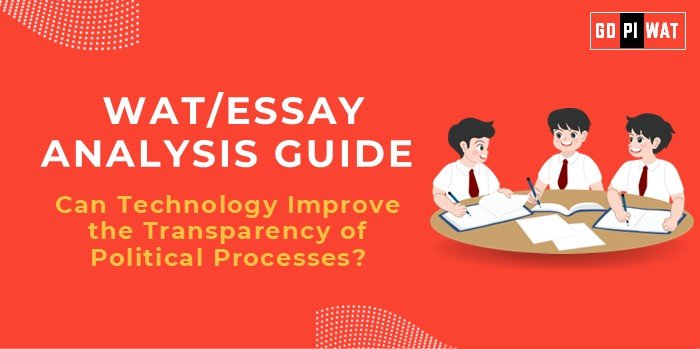📋 WAT/Essay Analysis Guide
🌐 Can Technology Improve the Transparency of Political Processes?
💡 Understanding the Topic
Technology has profoundly transformed various sectors globally, but its potential to enhance transparency in political processes is a critical subject of discussion. From digitized voting systems to open data platforms, the possibilities are immense.
🕒 Effective Planning and Writing
- Time Allocation:
- Planning: 5 minutes
- Writing: 20 minutes
- Review: 5 minutes
- Word Count Distribution:
- Introduction: 60-70 words
- Body: 350-375 words
- Conclusion: 60-70 words
📊 Quick Facts and Key Statistics
- 🌐 E-Governance Adoption: Over 80% of countries globally have e-governance systems (UN E-Government Survey 2023).
- 📋 Digital Voter Databases: India’s voter database digitization covers 950+ million voters, enhancing electoral transparency.
- 🔗 Blockchain in Voting: Blockchain trials in the US reduced vote fraud cases by 30%.
- 📂 Open Data: Over 100 countries have adopted Open Government Data (OGD) policies.
🎯 Achievements and Challenges
- Achievements:
- Estonia’s e-Government model ensures 99% of government services are online.
- Blockchain-based systems in Switzerland increased trust in elections.
- India’s Public Financial Management System tracks funds, reducing leakages.
- Challenges:
- Limited access to technology in rural areas.
- Cybersecurity risks, such as the AIIMS cyberattack.
- Policy delays due to political inertia.
🏗 Structured Arguments for Discussion
- Supporting Stance: “Technology fosters accountability through real-time monitoring and public engagement tools.”
- Opposing Stance: “Cybersecurity risks and digital literacy gaps hinder technology’s role in transparent governance.”
- Balanced Perspective: “While technology enhances transparency, bridging the digital divide and ensuring data security are paramount.”
🔍 Strategic Analysis of Strengths and Weaknesses
- Strengths: Increased accessibility to government data, efficient election monitoring.
- Weaknesses: Digital literacy gaps, resistance to technology adoption.
- Opportunities: AI for real-time policy analysis, blockchain for tamper-proof elections.
- Threats: Rising cyberattacks, misinformation campaigns.
📄 Connecting with B-School Applications
- Real-World Applications: Explore tech-driven transparency in public policy frameworks and CSR projects with e-governance elements.
- Sample Interview Questions:
- “How can blockchain revolutionize voting systems?”
- “Discuss the ethical concerns of using AI in governance.”
- Insights for B-School Students:
- Identify technology trends shaping global governance.
- Explore public-private partnerships in technology integration.


